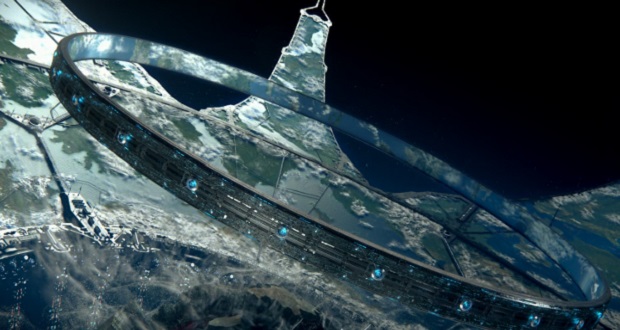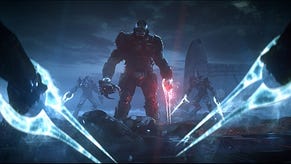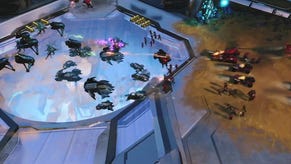Wot I Think: Halo Wars 2
A spartan design
Halo Wars 2 [official site] is undeniably a console RTS – a rare, exotic bird that looks a bit weird and could only have evolved on an island split off from the rest of the world. Removing it from its natural habitat and introducing it to the PC ecosystem, where its evolutionary niche isn't quite so niche, might seem a little cruel and ill-conceived. But while it’s certainly not a perfect fit, it’s striking and, more often than not, quite a lot of fun. Here’s wot I think.
It’s been a long time since Halo Wars first graced the Xbox 360, but it’s been longer still for the game's protagonists, the stalwart crew of the Spirit of Fire. They’ve been asleep for decades, only to return to a galaxy that’s changed. A post-Halo 5 galaxy. As Ron Perlman likes to remind us, however, some things never change; whatever else has happened while the crew have been sleeping, the Halo Universe still loves a good war. And so it is that the long lost Spartans and Marines find themselves embroiled in yet another conflict, even before they've wiped the sleep out of their eyes.
Remember the Brutes? The big gorilla-like aliens who served the Covenant? Well, they’ve rebelled, sent the Covenant packing, and their leader Atriox has claimed the Halo-building Ark as his new home. One ship stands in the way of his plans, and that's enough to kick the plot into gear, even if I’ve either forgotten what those plans were or they were never clearly expressed in the first place.
Halo Wars 2 spins a yarn that’s pretty typical of the main series – some high concept ideas made a little rote by a very simple narrative. For all the weird super weapons, nature reserves floating in the heavens and super-smart AIs, the campaign mostly just focuses on humans fighting evil aliens. Again. And then it ends awkwardly and abruptly to set up a sequel.
This three act war takes more than a few ideas from its FPS counterpart, with its exceptional Blur-created cutscenes – stunning works of CG art – and story-driven missions. Each of these 12 battles feels distinct, too. Not to the extent of, say, StarCraft 2, but there’s enough of a mix so that the campaign doesn’t outstay its welcome. Most missions take between 20-30 minutes to complete, so it’s a brief campaign, but it’s blessed with solid pacing and a good mix of objectives and scenarios.
It’s also surprisingly welcoming to Halo newcomers. It really doesn’t matter if you haven’t been paying much attention to what has become a massive and rich universe, because the crew of the Spirit of Fire have been out of the loop for years. Between the crew itself getting up to speed and the unlockable snippets of lore, it’s easy to get a grip on what the hell an Ark is and why everyone's so obsessed with the titular Halos.
Campaign highlights include fighting and even getting to control the ridiculously huge Scarab unit – one of two super units in the game – and giving orders to not one but three badass Spartans. The campaign is filled to the brim with thrilling, explosive moments, which almost makes up for some stinkers like holding an area for 30 minutes, which Creative Assembly seem to think is such a fun mission objective that they use it twice.
Let’s get back to the Spartans. Even though they appear as teeny, tiny warriors here, they are every bit as impressive as the likes of Master Chief. Every unit, from the vehicle-pounding Cyclops to the speedy and iconic Warthog, gets a special ability on top of its primary fire mode. The Warthog, for instance, revs up and slams into enemies with satisfying kinetic force. The Spartans are special, however. They get two equally fancy powers.
The first Spartan ability allows them to leap into the air and crush units when they nail their landing. This also lets them quickly jump off cliffs, surprising their foes below. Target a vehicle with that leap, though, and the ability changes. Instead of smashing into the vehicle, they hijack it. Every vehicle apart from the aforementioned super units is vulnerable to their superior hacking skills, allowing them to flit around the battlefield inside everything from the spry Wraiths to huge mechs bristling with rocket launchers. They feel every bit like the super soldiers the FPS makes them out to be.
While the unit selection is strong and their abilities often flashy, Halo Wars 2 never really seems to care how you use them. There are counter units, support units, myriad upgrades, but fights mostly just come down to who has the biggest blob of scrappers. I mean, you can try to play tactically, and you’ll probably need to – at least a little bit – when facing human opponents, but even then it’s more about army composition rather than being the smarter commander.
Controlling the Spartans, and every other aspect of Halo Wars 2’s vibrant and colourful battles, can feel a little off at times. Even when using a mouse and keyboard, it’s clear that concessions have been made for controllers. Units can be ordered to move, attack and use their special ability, but there’s little of the extra layer of control you might expect from a PC RTS. Your units constantly need to be micromanaged, there’s no patrol or guard options, and they’re cursed with poor pathfinding. The AI isn’t a serious threat, mind, and replacing units is a doddle, so if you do lose track of them, it’s not the end of the world.
These limitations aren’t all bad, however. Being able to relax on the sofa while playing an RTS using a controller is an enjoyable novelty, for one, but even if you’re playing Halo Wars 2 like a traditional RTS, the restrictions sometimes create interesting strategic wrinkles.
Base building definitely falls into this category. Instead of being able to place structures and defences wherever you please, maps are littered with predetermined base locations for HQs and mini-bases. Once you construct one, extra nodes appear around them, and that’s where you’ll plonk down your resource harvesting buildings, unit production facilities and your turrets. It seems horribly restrictive at first, but I’m now pretty sold on the idea.
If you need more energy or supplies – the game’s two resources, which are only generated by buildings because there are no resource nodes – you can’t just build a new generator or depot whenever or wherever you want. If you’ve already got one of each, chances are that you’ll need to destroy a building to make room for an extra one. Or you’ll need to explore, hopefully finding a node where you can set up a smaller base. This forces commanders to plan ahead and be willing to make the occasional sacrifice while also making build orders more reactive. It also encourages aggression and boldness. When you run out of space, you’re probably going to need to steal it from your opponent, destroying one of their bases and then building on its ashes.
Maps tend to be compact areas, full of winding paths that end in open battlefields. Units don’t move swiftly, especially in groups where their speed always matches the most sluggish unit, but battles are frenetic affairs where victories happen quickly. Despite their pace, there are plenty of opportunities for shifts in dominance and nasty surprises, largely thanks to powerful leader abilities. These nifty skills can be used to heal groups of units, drop down turrets or extra squads like ODST troops, or carpet bomb an entire area. Smart use of these game-changers can decide the outcome of a fight, but they have long cooldowns, so you’ve got to pick your moments.
While Halo Wars 2 has its fair share of multiplayer modes, often influenced by the FPS games, the standout is undoubtedly Blitz. It subtracts buildings and unit construction for pacy firefights over a trio of capture points, with troops and abilities being played via cards. It’s a deck-building game, then, with each faction and commander getting unique cards, as well as a few neutral ones. You need to fight over energy pods that fall from the heavens before spending that energy on new units and powers, so it’s not just a race to get to the capture points, but also battle over fleeting resources.
In the other modes, there’s little beyond aesthetics to make armies feel distinct, but in Blitz there are enough unique cards to make some pretty diverse loadouts. And of course there’s the randomisation factor, as you're never quite know what your hand is going to be. There’s usually a decent mix of powers and units, though, and I’ve never been in a position where I didn’t have anything worth playing. It helps that you can burn a card – for a cost – and immediately get a replacement. Cards costs are also generally low enough that you can field a beefy force with powerful units after only a short time, letting you get right into the thick of things and enjoy the type of scraps that you’d have to wait much longer for elsewhere.
Blitz is also the one place in Halo Wars where it feels like you’re being rewarded for being a clever, sneaky bastard. Because I’d played through the whole campaign before jumping into Blitz, I’d gotten used to just stomping around maps with one giant army, but that doesn’t really work here. It’s also not a good idea to spread your forces out; you’ve got to stay mobile.
Recently, I’ve been saving up my energy and leaving a single, expendable unit on the far side of a point. When the enemy storms it, I drop some mines – if I have them – and then summon what is essentially a brand new army. Maintaining line of sight of the capture points turns out to be even more important than keeping them defended.
Halo Wars 2 is simultaneously conservative and inventive. It’s definitely trying to evoke traditional RTS games – which is not entirely a bad thing given the recent dearth of them – especially when it comes to the campaign, but elements like base construction and Blitz mode make it stand out enough that it doesn’t feel like you’re just going through the motions for the hundredth time. A clumsy UI and weird, sometimes fixed, keybindings and controls reveal its console heritage, but there are a surprising number of benefits to that side of the design. Some of the places where the formula has been redesigned in order to appeal to the Xbox One crowd, and to fit a controller, are the points where Halo Wars 2 finds an identity of its own.
Halo Wars 2 is out tomorrow and is available through the Microsoft store for £49.74, and only runs on Windows 10 (also works on Xbox One with one purchase).





















